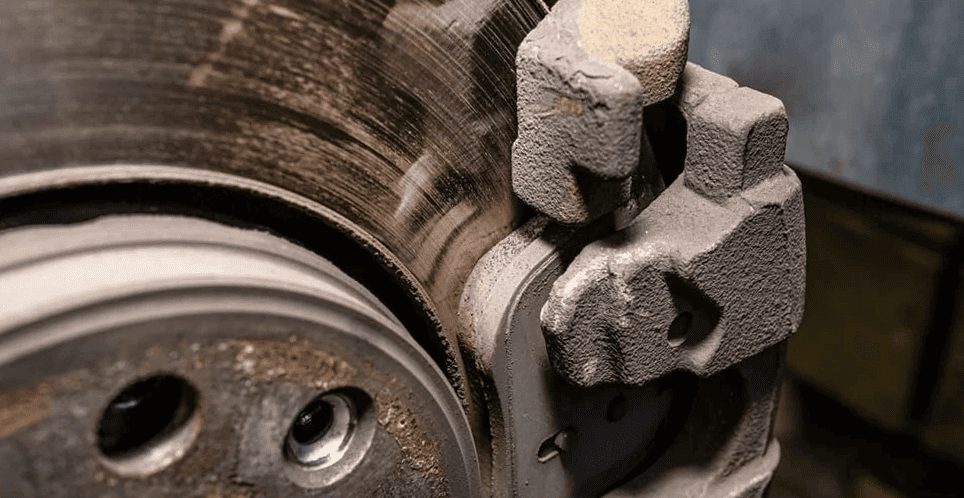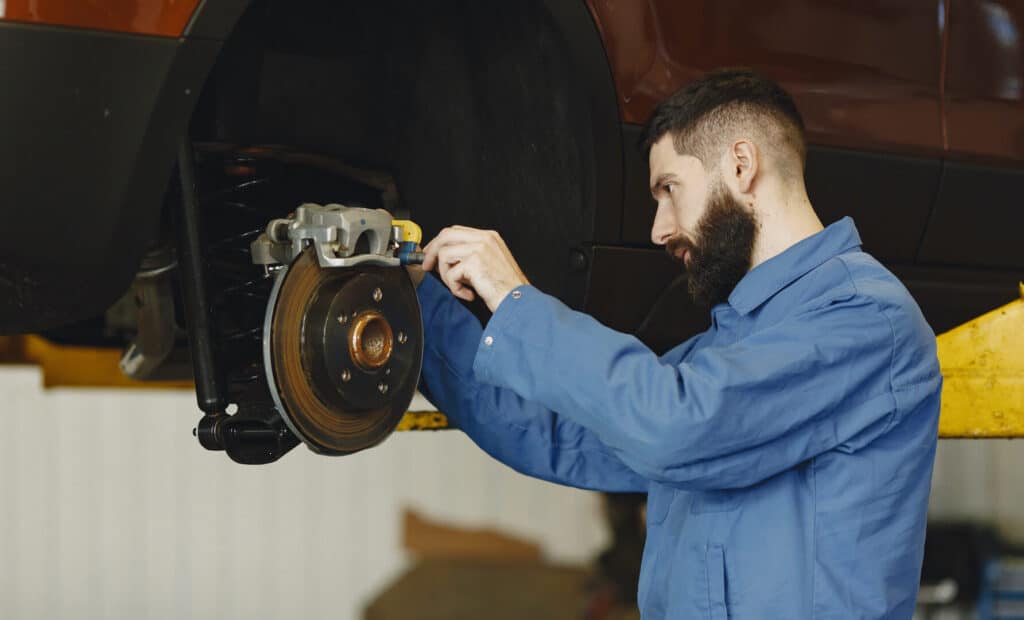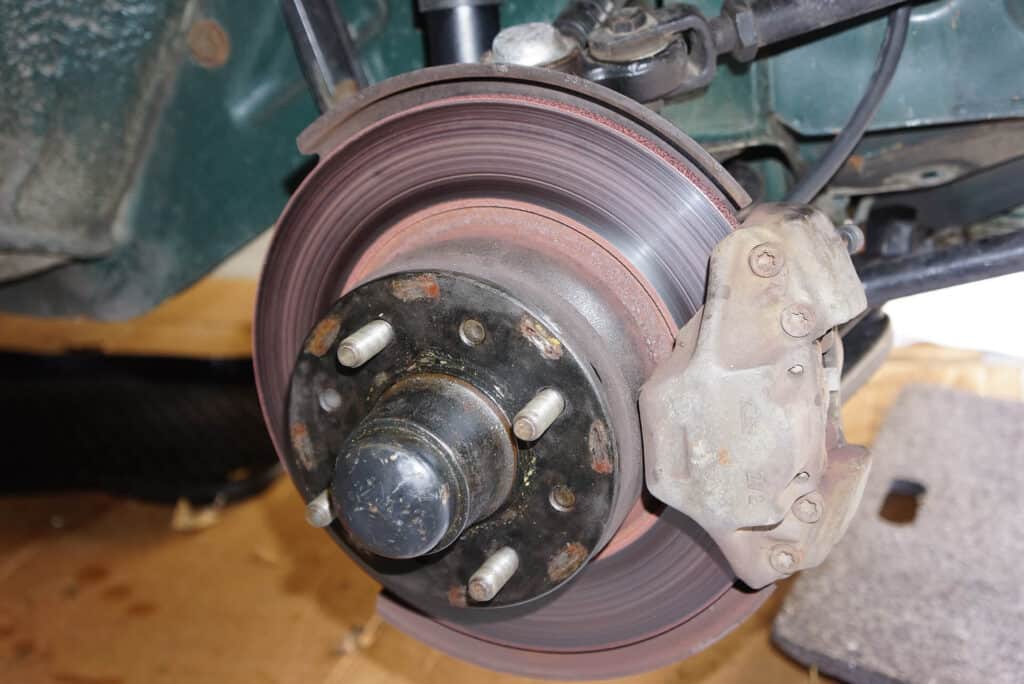Introduction
Brake calipers may not be the star of the show when it comes to car parts, but boy, do they play a significant role. Like the unsung heroes of your vehicle’s braking system, calipers are responsible for applying the force necessary to slow down and stop your vehicle. But what happens when they seize or get stuck? Let’s dive into the nitty-gritty.
Detecting the Problem: Signs Your Caliper is Seized or Stuck
Your vehicle has its ways of telling you when it’s feeling under the weather, and the symptoms of a seized caliper are no exception. Let’s take a closer look at the clues it might be dropping:
First off, if your vehicle starts to veer to one side when braking, that could be a symptom of a seized caliper. It’s as if your car has developed a mind of its own, stubbornly refusing to drive straight.
Next, your vehicle’s brakes are a team, and like any good team, the members should wear down at an even pace. If you notice uneven brake pad wear – with one side wearing down quicker than the other – this is another sign pointing to a potential caliper issue.
Have you noticed your vehicle feeling sluggish, as if it’s dragging? It’s not just throwing a tantrum. This could be due to the brake pads being unable to disengage from the rotor because the caliper is seized, making it harder for your vehicle to move.
Another symptom to watch out for is reduced braking performance. If it feels like your vehicle isn’t stopping as quickly or efficiently as it usually does, a seized caliper could be the cause. After all, if part of your brake system isn’t pulling its weight, it’s going to affect the team’s overall performance.

Let’s not forget about increased fuel consumption. When a caliper is seized, your engine has to work harder to move the vehicle, which can lead to increased fuel usage. If you’re noticing more frequent trips to the gas station, a seized caliper could be an unwelcome hitchhiker.
Finally, the heat generated by a stuck caliper can lead to overheating in the wheel hub area. If you’ve recently driven and feel excessive heat radiating from your wheel, that’s a red flag.
Recognizing these signs early on can save you from more costly repairs down the road, not to mention the safety risks of driving with a compromised brake system. Now, let’s shift gears and take a look at the causes behind caliper seizures.
Unearthing the Causes: Why Do Calipers Seize or Stick?
Picture your brake caliper as the diligent janitor of your car’s brake system. But just like janitors can fall sick, calipers can seize or stick. And the culprits behind this? Often, they are corrosion, dirt and debris, or the deterioration of caliper components due to age and wear.
Now, the last thing you want is a seizing caliper throwing a wrench in your journey. It’s like life; sometimes things get a bit sticky. But let’s break it down:
Corrosion is the villain of the piece. When exposed to water and salt (especially in those delightful Canadian winters), calipers can corrode. This corrosion can cause the brake piston inside the caliper to become stuck, preventing the piston from moving as it should.
Then there’s dirt and debris. These unwelcome guests can find their way into the caliper, creating blockages that impede the caliper’s movement. Even the smallest particle can turn your journey into a bumpy ride.
Lastly, the caliper components themselves aren’t immune to the ravages of time and wear. Over time, the rubber seals and boots that protect the caliper’s piston can degrade, reducing their effectiveness and potentially leading to a seized caliper.
Using Your Five Senses to Detect Caliper Issues
When it comes to detecting brake caliper problems, your senses are your best friends. Here’s how you can use each of them:
Sight: One of the first things you can do is visually inspect your brake caliper. If it looks rusty or dirty, that could be a sign of trouble. Also, watch out for uneven brake pad wear, which could indicate a sticky caliper.
Touch: When driving, you might feel a pulling sensation as you brake, indicating that one caliper is working harder than the others. If your vehicle feels like it’s dragging, or if it’s notably harder to accelerate, these might be signs of a seized caliper.
Hearing: If you’re hearing a squealing or grinding noise while braking, consider it an urgent telegram from your caliper, pleading for attention. These noises aren’t just annoying, they’re your early warning system of a potential caliper issue.
Smell: A burning smell after you’ve been driving could indicate a seized caliper. When a caliper sticks, it generates excessive heat from the constant friction, which can result in a noticeable smell.
Taste: Okay, so you won’t literally taste a seized caliper problem. But you will “taste” the impact on your wallet if the issue is ignored for too long.
Just like a doctor uses their senses to diagnose a patient, you can use yours to pick up on potential caliper issues early. But remember, your senses can only get you so far. A professional diagnosis is always the best course of action when dealing with brake issues. And that’s where Uchanics comes in, bringing the expertise right to your doorstep, no matter the weather.
Now, after all this sensory talk, you might wonder: can you continue your journey with a stuck caliper? Let’s shed some light on that next.
Safety Assessment: The Risks of Driving with a Seized or Stuck Caliper
Now, I can already hear your question echoing in the wind: “Is it safe to drive with a seized caliper?” In the most loving way possible, let me tell you: it’s as safe as juggling flaming swords. That is to say, not at all.
Driving with a seized caliper is a high-stakes gamble. It can lead to reduced braking efficiency, increased wear on other brake components, and faster tire wear. Not to mention the additional strain it puts on your engine, leading to increased fuel consumption.
But the granddaddy of all risks is a potential brake system failure. Imagine trying to stop your car at a busy intersection, only to find your brakes unresponsive. That’s a scene straight out of a nightmare, and it’s not one you want to star in.
In essence, driving with a seized or stuck caliper isn’t just a game of Russian roulette with your safety, it’s also a one-way ticket to more expensive repairs down the line. It’s like the old saying goes: a stitch in time saves nine. Addressing caliper issues early can save you a ton of trouble, not to mention, it can keep you and others around you safe.
So now you know the risks. But what if your caliper is already seized? How do you unstick this sticky situation? Let’s dive into that next.
How Long Does it Take to Replace a Seized Caliper and What is the Cost?
If you thought replacing a seized caliper was as easy as changing a light bulb, let me introduce you to reality. This job requires not just expertise, but also time. It’s not your everyday DIY project – unless, of course, you’re a seasoned mechanic with the right tools on hand.
How long, you ask? The average time to replace a brake caliper can range from 1-2 hours per wheel, assuming everything goes smoothly. Throw in some stubborn bolts or unexpected complications, and it could take a little longer.
And cost? Ah, the million-dollar (or at least a couple hundred-dollar) question. The cost to replace a brake caliper can depend on several factors, including the make and model of your vehicle and whether you’re replacing one or both calipers.

Here’s a rough breakdown for you
Parts: A new brake caliper typically costs between $100-$200, depending on the vehicle and whether you opt for a new or remanufactured part. Then there are the brake pads. If one caliper has seized, it’s often a good idea to replace the brake pads on both sides to ensure even braking. Brake pads can run anywhere from $25-$75 per set.
Labour: This is where the costs can add up. Mechanics charge by the hour, and the hourly rate can vary greatly depending on where you live. In Ontario, for example, you can expect to pay anywhere from $100-$160 per hour. Given the 1-3 hour timeframe we mentioned earlier, the labour cost can range from $100-$500
So, adding it all up, a rough estimate puts a caliper replacement job anywhere between $300-$1200.
Now, that’s a significant chunk of change. But remember what we discussed earlier: ignoring a seized caliper can lead to even more expensive repairs, not to mention potential accidents. When it comes to your brakes, it’s always better to be safe than sorry.
But wait, there’s more! When should you replace your calipers, and how long can you expect these contraptions to last? Let’s zoom in on that next.
Making the Call: When to Replace Calipers and Understanding their Lifespan
When you look in the mirror, you may notice a few more wrinkles than there used to be. Maybe you’re not as spry as you were in your younger years. Guess what? Your car’s calipers feel the same way. They age, they wear out, and eventually, they need replacing. It’s a fact of car life.
Typically, brake calipers have a lifespan of 75,000 to 100,000 km. But before you start scheduling that caliper birthday party, remember that this is an average. Your brake calipers don’t have a built-in expiry date. It’s not like they’re going to pack up and retire once they hit that 100,000 km mark. Their lifespan can be shorter or longer depending on several factors.
For starters, your driving habits can either extend or reduce the life of your brake calipers. If you’re a speed demon who loves to slam on the brakes, your calipers will wear out faster. In contrast, if you’re more of a ‘slow and steady wins the race’ kind of driver, your calipers will thank you with a longer life.
Next up, driving conditions. If you’re frequently navigating rough, dusty roads or areas with harsh weather, your calipers can seize up earlier. In contrast, those smooth, well-maintained city roads are a caliper’s dream come true.
So, how do you make the call? How do you know when it’s time to say goodbye to your old calipers and welcome in the new? It can be hard to tell, especially if you’re not well-versed in the language of brakes. That’s why it’s a good idea to have your brakes assessed by a professional mechanic at regular intervals or if you notice any issues.
That’s where we, at Uchanics, come in. Our mobile mechanics can come to you for a thorough inspection of your brake system. We’ll let you know if your calipers are still in their prime or if it’s time for a change. And if you do need new calipers, we can take care of that too, right on the spot.
After all, you wouldn’t trust just anyone with your heart health, would you? So why should your car’s “heart” – its braking system – be any different? At Uchanics, we believe in preventative maintenance, just like regular check-ups with your doctor. It’s all part of our mission to keep you, and your car, safe on the road. But enough about us, let’s move on and wrap this up with some final thoughts on brake caliper health.

Conclusion: Keeping Your Brake Calipers in Check for a Safe Drive
Ensuring your brake calipers are in top shape is as vital as fastening your seatbelt before a journey. It’s not just about keeping your vehicle running smoothly, it’s about ensuring your safety and the safety of others on the road. After all, brakes are the lifeline of your vehicle and calipers play a crucial role in that. Ignoring their health is not an option.
Regular checks and maintenance are the cornerstones of caliper care. A routine inspection can help catch issues early before they snowball into significant problems or costly repairs. It’s the same principle as regular dental check-ups to catch that tiny cavity before it turns into a root canal situation.
Then there’s the response to signs of trouble. If your car shows symptoms of a seized or sticking caliper, like pulling to one side, increased fuel consumption, or that oh-so-telling grinding noise, don’t dismiss it. These are not automotive hiccups that will correct themselves over time. They are the desperate SOS signals from your car begging for your attention.
Take action promptly. Whether it’s a DIY repair (for the mechanically inclined), or calling in the professionals, it’s essential to address the issue as soon as possible. Delaying can not only cause further damage to your vehicle but can also lead to dangerous driving situations. And trust us, a game of ‘chicken’ with a 2-ton vehicle and a malfunctioning brake is not a game you want to play.
In the end, remember this: your car is your loyal steed, a silent partner on all your journeys. It doesn’t ask for much, just a little TLC now and then. Take care of it, listen to it, and it will take care of you, taking you places safely and reliably. Because, in the grand theatre of life, where each journey marks a scene, no one wants a brake failure to be the plot twist.
Remember, keep your brake calipers in check for a safe drive, and when in doubt, reach out to professionals like Uchanics who can help keep your car – and your journeys – running smoothly.
Drive safe, dear reader. The road awaits.
